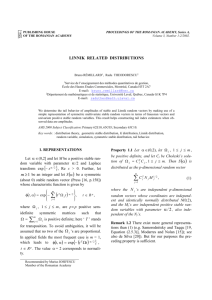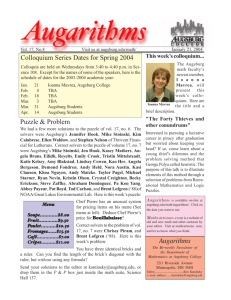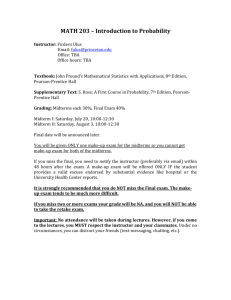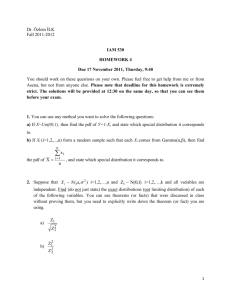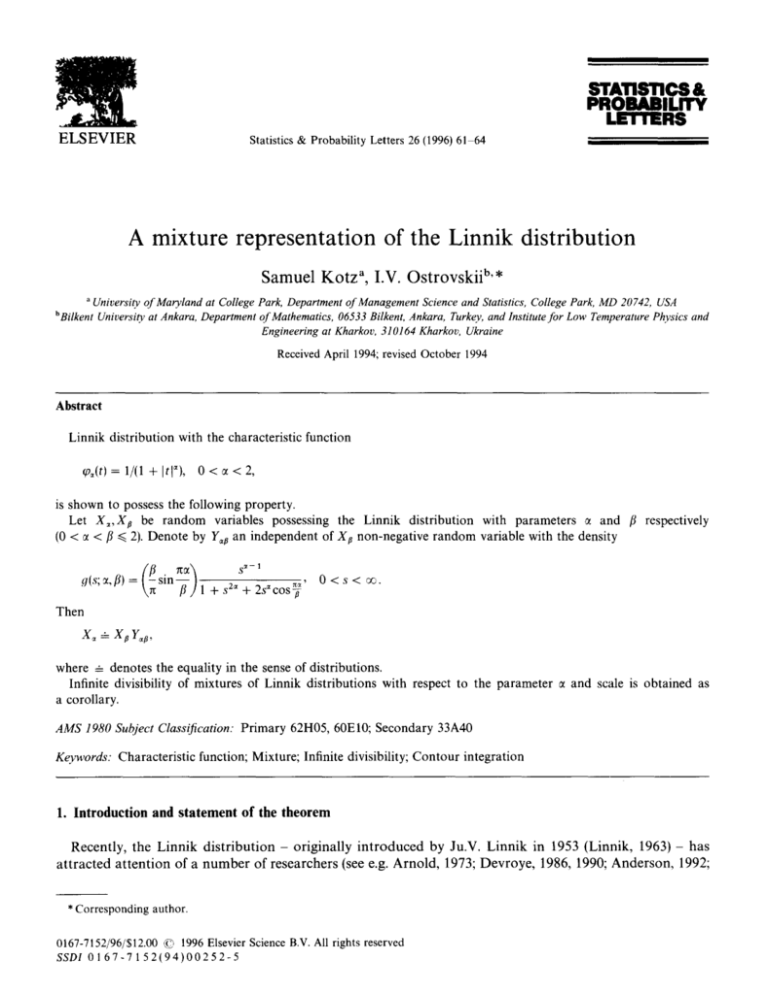
¢w'.
-
"
<"
r
STATISTICS&
PROBABILITY
LETTERS
ELSEVIER
Statistics & Probability Letters 26 (1996) 61 64
A mixture representation of the Linnik distribution
Samuel
K o t z a, I . V . O s t r o v s k i i b ' *
a Universi~ of Maryland at College Park, Department of Management Science and Statistics, College Park, MD 20742, USA
bBilkent Universi~ at Ankara, Department of Mathematics, 06533 Bilkent, Ankara, Turkey, and Institute for Low Temperature Physics and
Engineering at Kharkov, 310164 Kharkov, Ukraine
Received April 1994; revised October 1994
Abstract
Linnik distribution with the characteristic function
~o,(tl = 1/(1 + Itl=), 0 < ~ < 2,
is shown to possess the following property.
Let X , , X p be random variables possessing the Linnik distribution with parameters ~ and fl respectively
(0 < ~ < fl ~< 2). Denote by Y~ an independent of X~ non-negative random variable with the density
,q(s;~,fl) =
sin
1 + s 2~ + 2s c o s ~
Then
X, -'- X e Y~p,
where - denotes the equality in the sense of distributions.
Infinite divisibility of mixtures of Linnik distributions with respect to the parameter ~ and scale is obtained as
a corollary.
AMS 1980 Subject Classification."
Primary 62H05, 60El0; Secondary 33A40
Keywords: Characteristic function; Mixture; Infinite divisibility; Contour integration
1. Introduction and statement of the theorem
Recently, the L i n n i k d i s t r i b u t i o n - originally i n t r o d u c e d by Ju.V. L i n n i k in 1953 (Linnik, 1963) - has
a t t r a c t e d a t t e n t i o n of a n u m b e r of researchers (see e.g. A r n o l d , 1973; D e v r o y e , 1986, 1990; A n d e r s o n , 1992;
* Corresponding author.
0167-7152/96/$12.00 ~, 1996 Elsevier Science B.V. All rights reserved
SSDI 0 1 6 7 - 7 1 5 2 ( 9 4 ) 0 0 2 5 2 - 5
62
S. Kotz, I.V. Ostrovskii/Statistics & Probability Letters 26 (1996) 61-64
Anderson et al., 1993; Devroye, 1993). Although the characteristic function of this distribution is of a simple
form, a general expression of the distribution is not easily attainable. 1 In this connection, any properties of
the distribution such as a mixture representation which facilitates generation of Linnik random variables
ought to be of interest. One such property is proved in the present note.
Recall that the generic definition of a Linnik random variable is given in terms of the characteristic function
~p~(t)=l/(l+ltl~),
0<~<2.
We shall denote the corresponding density by p,(x). This density can be viewed as a generalization of the
well-known Laplace (double exponential) density p2(x) = c-Ixl/2 for the case c~ = 2 (see, e.g. Johnson and
Kotz, 1970). The main result of the paper is the following theorem.
Theorem. For any 0 < ~ < fl <~ 2, the following equality is valid
~p~(t) = r ~ ~ ~p~(t/s)g(s;~,fl)ds,
~
-
0o < t <
oc,,
(1)
u
where
9(s;~,fl)=(~sin~t~)
s~-I
l + s z~ + 2s ~cos
.
Noting that the equality (1) is equivalent to the following
p,(x)=ffp~(sx)g(s;~,B)ds, -~
<x<~,
and taking into account that g(s; ~, fl) is a genuine density function, we arrive at the representation of the form
X~ - X~ Yap,
as stipulated in the abstract. This representation allows us to generate Linnik variables of different
parameters starting from convenient base, e.g. from the Laplace distribution corresponding to fl = 2. That is,
our theorem yields immediately the following corollary.
Corollary 1. For any ~ ~ (0, 2), Linnik distribution with characteristic function q~,(t) is a scale mixture of
Laplace distributions with characteristic functions ~02(t/s) = s2/(s 2 + t2), 0 < s < ~ .
By Steutel's theorem (Steutel, 1970), any scale mixture of Laplace distributions is infinitely divisible.
Therefore, Corollary 1 yields infinite divisibility of Linnik distributions. This fact is not new and was proved
in Devroye (1990). However, noting that any mixture of scale mixtures of Laplace distributions is again
a scale mixture of Laplace distributions, we obtain a stronger result: any mixture of Linnik distributions is
infinitely divisible. More precisely, the following result is valid.
Corollary 2. Let P be a probability measure on the half-strip S = {(~,s): 0 < ~ ~< 2, 0 ~< s < ~ } . Then the
distribution with the characteristic function
~o(t) = f s (o~(st)P(d~ ds)
is infinitely divisible.
1See Hayfavi,A., S. Kotz and I.V. Ostrovskii (1994),Analyticand asymptoticpropertiesof Linnik's probabilitydensities, C,R. Acad.
Sci. Paris, S6rie I, 319, 985 990.
63
S. Kotz, L V. Ostrovskii / Statistics & ProbabiBty Letters 26 (1996) 61-64
2. Proof of the theorem
Note, that the equality (1) is equivalent to the following one:
f ~ s 7~-~+tpO(s;~,[l)ds,
~
1 - ~° -t 1
0<~<fl~<2,
t>~O.
= f:
S/~+°- lds
T o prove the latter, we denote
I
__
/I;
flsin-~
f:
.
S'
s-g--~+t~9(s'ct'fl)ds
/tO¢
(s p + t~)(1 + s 2° + 2s O cos~-)
It is sufficient to establish that
rc
I = - flsin~
1
(2)
1 + t°
Transforming the integral I by means of the change of variables z = t p s -~, we have
z(°/tJ)-'dz
I =~
(1 + z)(z 2°/p + t E° + 2z°/#t°cos~)
Utilizing the identity
we have
I
1
{f~
z('/')- t dz
2iflsin~
(1 + z)(z °/~ + t°e -i~/~) -
I]
}
(1 + z)(T°/# + t°e i'°/e) '
(3)
Consider the function
q(z) =
1
(4)
(1 + z)(z °/~ + t°ei~/P) '
in the complex z-plane cut along the positive ray. Define the branch of z °/~ in (4) by the conditions
z ~/~ = r "/p e i~/l~, z = re i~°,
0 < (p < 2re.
Since
when 0 < ~o < 2re, we have
zo/; + t • em/B = ei~/~(rO/~ + t, eiO/p(~- o)) 4= O.
Therefore the function q(z) is analytic in the cut out plane. Denote by GR,~ the simply connected region
GR,,: = {z: ~ < Izl < R}\{z: s < z < R}, 0 < e < R ( > 1)
and denote by t?Gg.~ its b o u n d a r y traversed in the direction which leaves GR., from the left (the line interval
{z: e < z < R } is being traversed twice in the opposite directions). By the Cauchy Residue Theorem, we have
~,~
a~,q(z)dz = 2~i(Residue of q(z) at z = - 1) -
2~i
1 + t °"
64
S. Kotz, I.V. Ostrovskii / Statistics & Probability Letters 26 (1996) 61-64
Taking the limit of the last integral as R ~ oo, e, ~ 0, we arrive at
fo
v(,/p)- 1 dr
~] f;
_
~'~/~'-ldz
(1 + z)(z "/¢ + t'e ~'/~) - e2ni[(~///)
(1 + "c)(z'~/Pe2ni~//~ -+- t'e i~'/~)
12rri
+ t ~"
It is evident that this equality can be rewritten in the form
f;
r~'/~)-ldr
_f;
(1 + z)(v "/a + t'e i~'/e)
rl'/')- 1 d~
_
(1 + z)(z "/p + t'e -i~/~)
2~zi
1 + t"
Thus, the difference of the integrals appearing in the braces of (3) has been calculated to be equal to
2hi/(1 + t'). Substituting this value into (3), we arrive at (2). The theorem is thus proved.
References
Anderson, D.N. (1992), A multivariate Linnik distribution, Statist. Probab. Lett. 14, 333-336.
Anderson, D.N. and B.C. Arnold (1993), Linnik distributions and processes, J. Appl. Probab. 30, 330-340.
Arnold, B.C. (1973), Some characterizations of the exponential distribution by geometric compounding, SIAM J. Appl. Math. 24,
24~244.
Devroye, L. (1986), Non-Uniform Random Variable Generation (Springer, New York).
Devroye, L. (1990), A note on Linnik's distribution, Statist. Probab. Lett. 9, 305-306.
Devroye, L. (1993), A triptych of discrete distributions related to stable law, Statist. Probab. Lett. 18, 349 351.
Johnson, N.L. and S. Kotz (1970), Distributions in Statistics, Continuous Univariate Distributions, II (J. Wiley, New York).
Linnik, Ju.V. (1963), Linear forms and statistical criteria, I, II, Selected Translations in Math. Statist. Probab. 3, 140. (Original paper
appeared in: Ukrainskii Mat. Zhournal 5 (1953) 207-290.)
Anderson, D.N. and B.C. Arnold (1993), Linnik distributions and processes, J. Appl. Probab. 30, 330-340.
Steutel, F.W. (1970), Preservation of Infinite Divisibility under Mixino and Related Topics, Vol. 33 (Mathematical Center Tracts,
Mathematisch Centrum, Amsterdam).

